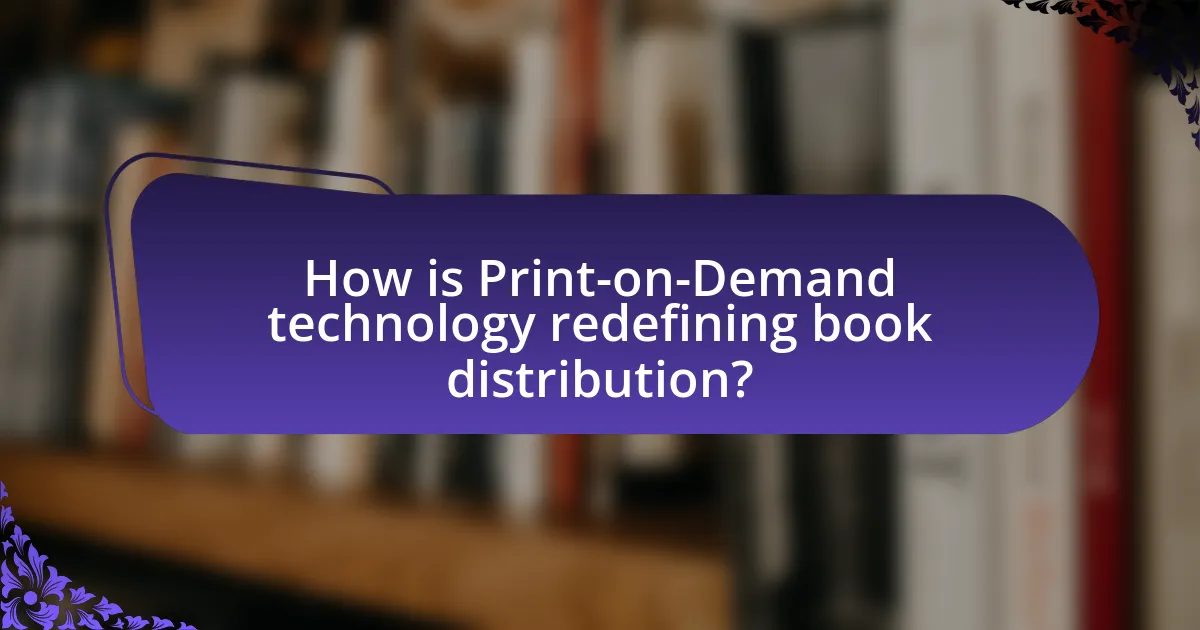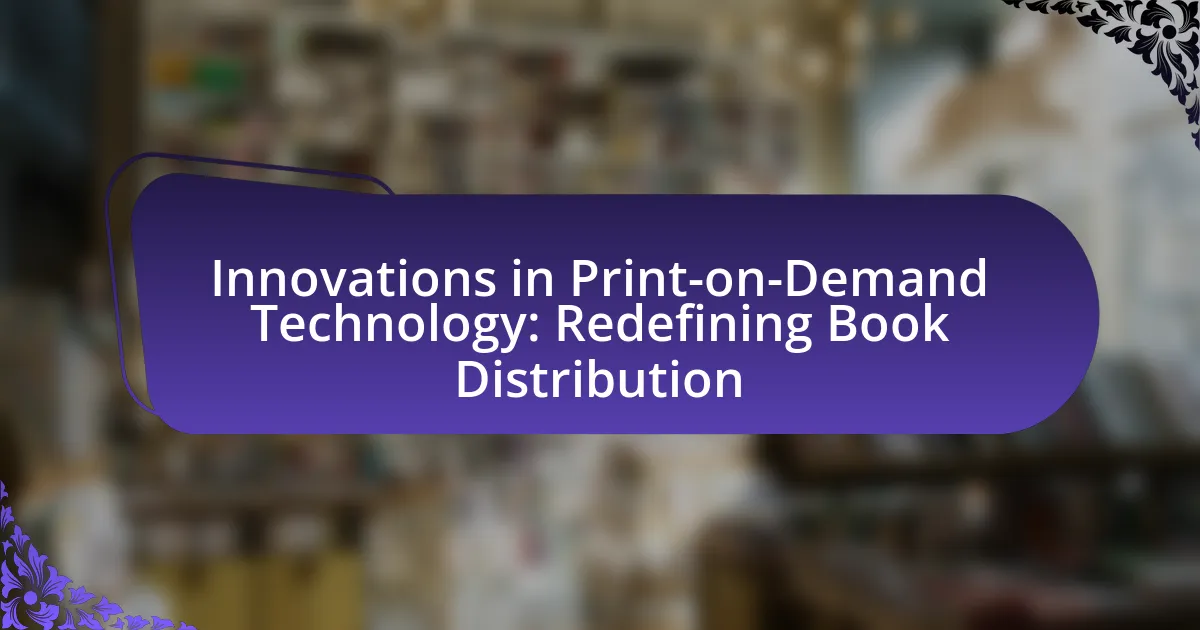Innovations in print-on-demand technology are transforming the landscape of book distribution by introducing advanced digital printing techniques, automated order fulfillment systems, and enhanced customization options. These developments enable faster production times, reduced inventory costs, and the ability to cater to consumer demand for personalized products. The evolution of print-on-demand has shifted from basic printing services to sophisticated digital solutions, allowing for greater accessibility and a wider range of titles. Key features include automated workflows, improved print quality, and the integration of artificial intelligence for optimized inventory management, all of which contribute to a more efficient and sustainable publishing model. This article explores the technological advancements driving these changes, their impact on traditional printing methods, and the future trends shaping the print-on-demand industry.

What are Innovations in Print-on-Demand Technology?
Innovations in print-on-demand technology include advancements such as improved digital printing techniques, automated order fulfillment systems, and enhanced customization options. These innovations enable faster turnaround times, reduce inventory costs, and allow for personalized products, which cater to consumer demand for unique items. For instance, advancements in inkjet and laser printing have significantly increased print quality and speed, while automation in fulfillment processes has streamlined operations, allowing publishers to respond quickly to market trends. Additionally, platforms that integrate artificial intelligence for demand forecasting further optimize inventory management, ensuring that print runs are efficient and cost-effective.
How has Print-on-Demand technology evolved over the years?
Print-on-Demand (POD) technology has evolved significantly since its inception in the late 20th century, transitioning from basic printing services to sophisticated digital solutions. Initially, POD was limited to simple black-and-white printing, but advancements in digital printing technology have enabled high-quality color printing and faster turnaround times. By the early 2000s, the integration of online platforms allowed authors and publishers to easily upload their works, streamlining the distribution process.
The introduction of automated workflows and improved printing equipment has further enhanced efficiency, reducing costs and waste associated with traditional printing methods. According to a report by Smithers Pira, the global POD market is projected to grow significantly, driven by the increasing demand for customized and short-run printing solutions. This evolution has redefined book distribution, allowing for greater accessibility and a wider range of titles to reach readers without the need for large print runs.
What technological advancements have driven these changes?
Technological advancements that have driven changes in print-on-demand technology include digital printing, automated workflow systems, and cloud-based platforms. Digital printing technology allows for high-quality, cost-effective production of books in small quantities, eliminating the need for large print runs and inventory storage. Automated workflow systems streamline the publishing process, enabling faster turnaround times from manuscript to printed book. Cloud-based platforms facilitate easy access to publishing tools and distribution networks, allowing authors and publishers to reach global markets efficiently. These advancements collectively enhance the accessibility and flexibility of book distribution, catering to diverse consumer demands.
How do these innovations differ from traditional printing methods?
Innovations in print-on-demand technology differ from traditional printing methods primarily in their ability to produce books in smaller quantities and with greater customization. Traditional printing methods typically require large print runs, which can lead to excess inventory and higher upfront costs, while print-on-demand allows for single copies or small batches to be printed as needed, reducing waste and financial risk. Additionally, print-on-demand technology enables authors and publishers to easily update content and designs without incurring significant costs, a flexibility not available in traditional methods that often involve lengthy reprinting processes. This shift is supported by advancements in digital printing technology, which have made high-quality, cost-effective printing accessible for a wider range of titles and formats.
What are the key features of modern Print-on-Demand technology?
Modern Print-on-Demand technology features automated production, allowing for on-the-fly printing of books and other materials as orders are received. This technology minimizes inventory costs and waste by producing items only when there is demand, which is supported by advancements in digital printing techniques that ensure high-quality outputs. Additionally, integration with e-commerce platforms enables seamless order processing and fulfillment, enhancing the efficiency of distribution. The scalability of Print-on-Demand allows publishers and authors to offer a wider range of titles without the financial risk associated with traditional printing methods.
How does digital printing enhance the Print-on-Demand process?
Digital printing enhances the Print-on-Demand process by enabling faster production times and greater customization options. This technology allows for immediate printing of materials as orders are received, eliminating the need for large inventory and reducing waste. According to a study by Smithers Pira, digital printing can reduce turnaround times by up to 75% compared to traditional printing methods. Additionally, digital printing supports variable data printing, which allows for personalized content in each print run, catering to specific customer needs and preferences. This capability not only improves customer satisfaction but also opens new market opportunities for publishers and businesses.
What role does automation play in Print-on-Demand services?
Automation plays a crucial role in Print-on-Demand services by streamlining production processes and enhancing efficiency. It enables automatic order processing, reducing the time from order placement to fulfillment, which is essential for meeting customer demands in a timely manner. For instance, automated systems can manage inventory, print, and ship products without human intervention, significantly lowering operational costs and minimizing errors. According to a report by Smithers Pira, automation in printing can increase productivity by up to 30%, demonstrating its effectiveness in optimizing workflows within Print-on-Demand services.
Why is Print-on-Demand technology important for book distribution?
Print-on-Demand technology is important for book distribution because it allows publishers to produce books only as they are ordered, significantly reducing inventory costs and waste. This model enables authors and small publishers to offer a wider range of titles without the financial burden of large print runs. According to a study by the Book Industry Study Group, Print-on-Demand has led to a 30% increase in the availability of niche titles, making it easier for readers to access diverse content. Additionally, it streamlines the supply chain, allowing for faster delivery times and more efficient distribution processes.
How does it impact inventory management for publishers?
Print-on-demand technology significantly impacts inventory management for publishers by reducing the need for large print runs and minimizing excess stock. This innovation allows publishers to print books only as orders are received, which decreases storage costs and mitigates the risk of unsold inventory. According to a study by the Book Industry Study Group, print-on-demand can lower inventory costs by up to 30%, enabling publishers to allocate resources more efficiently and respond quickly to market demand.
What advantages does it offer to independent authors?
Print-on-demand technology offers independent authors significant advantages, including reduced upfront costs and increased control over the publishing process. This technology eliminates the need for large print runs, allowing authors to publish their work without financial risk, as books are printed only when ordered. Additionally, independent authors can maintain creative control over their content, cover design, and pricing, enabling them to tailor their work to specific audiences. According to a report by the Book Industry Study Group, the print-on-demand market has grown significantly, indicating a shift towards more accessible publishing options for independent authors.

How is Print-on-Demand technology redefining book distribution?
Print-on-Demand (POD) technology is redefining book distribution by enabling publishers to print books only as they are ordered, significantly reducing inventory costs and waste. This model allows for a more flexible and responsive supply chain, where titles can be produced in small quantities or even individually, catering to niche markets and specific reader demands. According to a report by IBISWorld, the POD market has grown substantially, with an annual growth rate of 5.5% from 2016 to 2021, highlighting its increasing adoption in the publishing industry. This shift not only democratizes access to publishing for authors but also enhances the availability of diverse titles for readers, as books no longer need to meet traditional print run thresholds to be viable.
What changes are occurring in the traditional book distribution model?
The traditional book distribution model is undergoing significant changes primarily due to the rise of print-on-demand technology. This innovation allows publishers to produce books only as they are ordered, reducing the need for large print runs and extensive inventory storage. As a result, smaller publishers and independent authors can enter the market more easily, as they face lower upfront costs and risks associated with unsold inventory. Additionally, print-on-demand services enable faster turnaround times and greater customization options for readers, which enhances the overall consumer experience. This shift is supported by data indicating that the print-on-demand market is projected to grow significantly, reflecting a broader trend towards on-demand services across various industries.
How does Print-on-Demand reduce the need for large print runs?
Print-on-Demand (POD) reduces the need for large print runs by allowing books to be printed individually as orders are received, rather than requiring a minimum quantity to justify a print run. This technology eliminates the risk of overproduction and excess inventory, which is common in traditional printing methods that necessitate large upfront investments. According to a study by the Book Industry Study Group, POD can significantly lower costs associated with storage and unsold stock, making it a financially viable option for publishers and authors.
What implications does this have for bookstores and retailers?
Innovations in print-on-demand technology significantly impact bookstores and retailers by enabling them to reduce inventory costs and respond more flexibly to consumer demand. This technology allows retailers to print books as needed, minimizing the risk of overstock and associated financial losses. According to a report by the Book Industry Study Group, print-on-demand can lower the cost of unsold inventory by up to 30%, making it a financially viable option for smaller bookstores. Additionally, this innovation facilitates a broader selection of titles, as retailers can offer niche or self-published works without the constraints of traditional distribution models. Consequently, bookstores can enhance customer satisfaction by providing a more diverse range of products tailored to local preferences.
How does Print-on-Demand technology affect global reach for authors?
Print-on-Demand (POD) technology significantly enhances the global reach for authors by enabling them to publish and distribute their works without the need for large print runs or upfront costs. This technology allows authors to make their books available online, where they can be printed and shipped directly to customers worldwide as orders are placed. As a result, authors can access international markets that were previously difficult to penetrate due to logistical and financial barriers.
For instance, according to a report by the Book Industry Study Group, POD has contributed to a 30% increase in the availability of titles in global markets since its adoption. This accessibility empowers authors to reach diverse audiences, increase their visibility, and potentially boost sales without the constraints of traditional publishing models.
What are the benefits of localized printing for international markets?
Localized printing for international markets offers several key benefits, including reduced shipping costs, faster delivery times, and enhanced cultural relevance. By producing materials closer to the target audience, companies can significantly lower transportation expenses, which is particularly important in a globalized economy where shipping fees can be substantial. Additionally, localized printing allows for quicker turnaround times, enabling businesses to respond rapidly to market demands and trends. This agility is crucial in maintaining competitiveness. Furthermore, localized printing ensures that content is culturally tailored, which increases engagement and resonance with local consumers. For instance, a study by the International Journal of Marketing Studies found that culturally relevant marketing materials can improve customer response rates by up to 30%. These advantages collectively enhance operational efficiency and market penetration for businesses operating in international markets.
How does this technology facilitate access to niche markets?
Print-on-demand technology facilitates access to niche markets by enabling publishers to produce books in small quantities without the need for large upfront investments. This model allows authors and publishers to cater to specific audiences, such as specialized genres or topics, that may not have sufficient demand for traditional print runs. For instance, according to a report by the Book Industry Study Group, print-on-demand has significantly reduced the barriers to entry for self-publishing, allowing authors to reach targeted readers effectively. As a result, niche markets can thrive, as creators can offer unique content tailored to specific interests without the risk of unsold inventory.
What challenges does Print-on-Demand technology face in the industry?
Print-on-Demand technology faces several challenges in the industry, including high production costs, limited scalability, and quality control issues. High production costs arise from the need for specialized equipment and materials, which can deter small publishers and independent authors. Limited scalability is a concern as demand fluctuates, making it difficult to maintain efficient operations without incurring additional expenses. Quality control issues can occur due to variations in printing processes and materials, leading to inconsistent product quality, which can negatively impact customer satisfaction and brand reputation. These challenges hinder the widespread adoption and effectiveness of Print-on-Demand technology in redefining book distribution.
How do quality control issues impact customer satisfaction?
Quality control issues significantly diminish customer satisfaction by leading to product defects, inconsistencies, and unmet expectations. When customers receive products that do not meet quality standards, such as poorly printed pages or incorrect binding in print-on-demand books, their trust in the brand erodes. Research indicates that 70% of customers are likely to switch brands after a negative experience, highlighting the direct correlation between quality control and customer loyalty. Furthermore, consistent quality issues can result in negative reviews and decreased repeat purchases, ultimately impacting a company’s reputation and profitability in the competitive print-on-demand market.
What are the limitations of Print-on-Demand in terms of production speed?
Print-on-Demand (POD) has significant limitations in terms of production speed, primarily due to the time required for printing and fulfillment processes. Unlike traditional printing methods that can produce large quantities quickly, POD operates on a per-order basis, which inherently slows down production. Each item must be printed individually, leading to longer turnaround times, often ranging from a few days to weeks, depending on the complexity of the order and the efficiency of the printing technology used. Additionally, factors such as equipment maintenance, supply chain delays for materials, and shipping logistics further contribute to slower production speeds compared to bulk printing methods.

What are the future trends in Print-on-Demand technology?
Future trends in Print-on-Demand technology include advancements in automation, increased customization options, and integration with artificial intelligence. Automation is streamlining production processes, reducing turnaround times, and enhancing efficiency, as evidenced by companies like Printful and Printify, which utilize automated workflows to fulfill orders rapidly. Increased customization allows consumers to personalize products more extensively, with platforms enabling unique designs and variations, catering to niche markets. Additionally, the integration of artificial intelligence is optimizing inventory management and predicting consumer preferences, as seen in the use of AI algorithms by major print-on-demand services to analyze sales data and adjust offerings accordingly. These trends indicate a shift towards more efficient, personalized, and data-driven print-on-demand solutions.
How is artificial intelligence influencing Print-on-Demand services?
Artificial intelligence is significantly influencing Print-on-Demand services by enhancing personalization, optimizing inventory management, and improving design processes. AI algorithms analyze customer data to tailor product offerings, ensuring that consumers receive personalized recommendations based on their preferences and purchasing behavior. For instance, AI-driven tools can predict trends and automate the design process, allowing creators to generate unique designs that resonate with target audiences. Additionally, AI optimizes inventory management by forecasting demand more accurately, reducing waste and ensuring that print runs align with market needs. This integration of AI technologies leads to increased efficiency and customer satisfaction in the Print-on-Demand sector.
What potential does AI hold for personalized book printing?
AI holds significant potential for personalized book printing by enabling tailored content creation and efficient production processes. Through advanced algorithms, AI can analyze reader preferences and generate customized narratives, illustrations, or layouts that resonate with individual tastes. For instance, AI-driven tools can curate book recommendations based on user data, leading to unique editions that cater to specific demographics or interests. Additionally, AI enhances print-on-demand technology by optimizing print runs, reducing waste, and streamlining supply chains, which can lower costs and improve turnaround times. This capability is supported by industry advancements, such as the integration of machine learning in print workflows, which has been shown to increase operational efficiency by up to 30%.
How might AI improve operational efficiency in Print-on-Demand?
AI can significantly enhance operational efficiency in Print-on-Demand by automating various processes such as inventory management, order processing, and customer service. For instance, AI algorithms can predict demand trends based on historical sales data, enabling businesses to optimize their inventory levels and reduce waste. Additionally, AI-driven chatbots can handle customer inquiries and support, streamlining communication and freeing up human resources for more complex tasks. According to a study by McKinsey, companies that implement AI in their operations can achieve productivity gains of 20-25%, demonstrating the tangible benefits of AI integration in Print-on-Demand systems.
What role will sustainability play in the future of Print-on-Demand?
Sustainability will play a crucial role in the future of Print-on-Demand by driving eco-friendly practices and reducing waste in the publishing industry. As consumer awareness of environmental issues increases, Print-on-Demand services are expected to adopt sustainable materials and processes, such as using recycled paper and eco-friendly inks. According to a report by Smithers Pira, the global market for sustainable packaging is projected to reach $500 billion by 2024, indicating a significant shift towards environmentally responsible practices. This trend will not only meet consumer demand but also enhance brand reputation and compliance with regulations aimed at reducing carbon footprints.
How can Print-on-Demand technology contribute to eco-friendly publishing?
Print-on-Demand technology contributes to eco-friendly publishing by significantly reducing waste associated with traditional printing methods. This technology allows books to be printed only when an order is placed, eliminating the need for large print runs that often result in unsold inventory. According to a study by the Book Industry Study Group, print-on-demand can reduce paper waste by up to 50% compared to conventional publishing practices. Additionally, it minimizes the carbon footprint associated with transportation, as books are printed closer to the customer, reducing shipping distances. Thus, Print-on-Demand not only conserves resources but also promotes sustainable practices in the publishing industry.
What practices can be adopted to minimize waste in the process?
Adopting practices such as digital printing, on-demand production, and efficient inventory management can significantly minimize waste in the print-on-demand process. Digital printing reduces excess material usage by producing only the required number of copies, thereby eliminating overproduction. On-demand production allows for printing books only when ordered, which prevents unsold inventory from becoming waste. Efficient inventory management, including real-time tracking and data analysis, helps in forecasting demand accurately, further reducing the likelihood of excess stock. These practices collectively contribute to a more sustainable and waste-efficient book distribution model.
What best practices should authors and publishers follow when using Print-on-Demand?
Authors and publishers should ensure high-quality formatting and design when using Print-on-Demand to enhance the visual appeal and readability of their books. Proper formatting includes adhering to industry standards for margins, fonts, and layout, which can significantly impact the reader’s experience. Additionally, authors and publishers should conduct thorough proofreading and editing to eliminate errors, as Print-on-Demand allows for quick updates and corrections, ensuring that the final product meets professional standards.
Moreover, selecting a reliable Print-on-Demand service is crucial; this includes evaluating print quality, distribution options, and customer service. Research indicates that authors who choose reputable providers often experience better sales and customer satisfaction. Finally, effective marketing strategies tailored to the Print-on-Demand model, such as leveraging social media and online platforms, can significantly increase visibility and sales, as evidenced by the growing trend of self-published authors successfully utilizing these channels.
How can authors effectively market their Print-on-Demand books?
Authors can effectively market their Print-on-Demand books by leveraging social media platforms, engaging in targeted advertising, and utilizing email marketing campaigns. Social media allows authors to connect directly with potential readers, share content related to their books, and build a community around their work. For instance, platforms like Instagram and Facebook can be used to showcase book covers, share behind-the-scenes content, and run promotional giveaways, which can increase visibility and engagement.
Targeted advertising, particularly through platforms like Facebook Ads or Google Ads, enables authors to reach specific demographics that align with their book’s genre and audience. This approach can lead to higher conversion rates as ads are shown to individuals who are more likely to be interested in the content.
Email marketing campaigns are also crucial; authors can build a mailing list to keep readers informed about new releases, special promotions, and events. According to a study by the Direct Marketing Association, email marketing has an average return on investment of $42 for every dollar spent, highlighting its effectiveness in reaching and engaging an audience.
By combining these strategies, authors can create a comprehensive marketing plan that maximizes the reach and sales potential of their Print-on-Demand books.
What are the common pitfalls to avoid in Print-on-Demand publishing?
Common pitfalls to avoid in Print-on-Demand publishing include poor quality control, inadequate market research, and neglecting marketing efforts. Poor quality control can lead to unsatisfactory products, as many Print-on-Demand services may not meet the expected standards for print quality, affecting customer satisfaction. Inadequate market research can result in publishing books that do not resonate with the target audience, leading to low sales. Neglecting marketing efforts is detrimental because even the best books require promotion to reach potential readers; without a solid marketing strategy, visibility and sales can significantly decline. These pitfalls are critical to recognize, as they can directly impact the success of a Print-on-Demand publishing venture.



